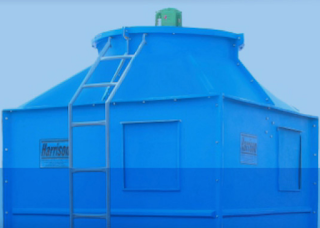IMPERATIVE YET DIVERSIFIED COOLERS
A cooling tower is a heat rebuff device
that throw-outs waste heat to the air through the cooling of a water stream to
a lesser temperature. Cooling
towers may either use the vaporization of water to eliminate process heat
and cool the occupied fluid to near the wet-bulb air temperature or, in the
case of closed circuit dry cooling towers, rely solely on air to cool the
working fluid to near the dry-bulb air temperature. Public applications include
cooling the mingling water used in oil refineries, petrochemical and other chemical
plants, thermal power posts and HVAC systems for cooling buildings.
Cooling towers vary in size from small
roof-top units to very large hyperboloid structures (as in the adjacent image)
that can be up to 200 meters (660 ft.) tall and 100 meters (330 ft.) in
diameter, or rectangular constructions that can be above 40 meters (130 ft.)
tall and 80 meters (260 ft.) long. Though these large towers are very protruding,
the huge bulk of cooling towers are much lesser, comprising various units mounted
on or near buildings to release heat from air conditioning. In low-humidity zones,
evaporative
air coolers can deliver an energy-efficient and regular technique of
cooling. Swamp coolers, work by transient outdoor air over water-soaked pads, and
this roots water to evaporate into the pad. The cooled air, which ranges from
15 to 40 degrees Fahrenheit, is then heading for into a home.
The considerable
energy savings alone make evaporative cooling a better choice compared to refrigerate
cooling which uses a great amount of energy. The low maintenance of swamp coolers
and the filtered air are great bonuses. Another benefit of evaporative coolers
is the low cost of fitting, which is partial the cost of connecting a central
air unit. However, Closed circuit cooling tower, or dry cooling tower,
involves no contact between the air and the fluid being cooled. This tower has
two separate fluid circuits, one in which the fluid is recirculated on the
outside of the second circuit, which is a bundle of tubes through which the hot
water is flowing. The air drawn through this cascading water provides
evaporative cooling similar to an open cooling tower, except that the cooled
water never makes direct contact with the air. Hence, these are various types
of coolers one must know about.




Comments
Post a Comment